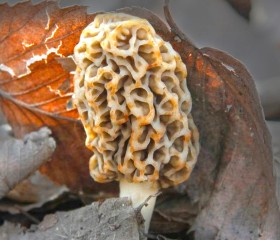Fleshy, cream colored, and fenestrated, delicious Morels are hollow, with a bulbous fruit that seems to appear overnight, rising from the ground into sunlight after a rain. In April in Missouri we found them growing in a magical place beneath a giant sycamore tree, nestled into a surreal carpet of Virginia Bluebells. On the way in was a moat of stinging nettles, shoulder high, that could prick you through your shirt and leave you itching and aching for hours. But once arrived, this was like no other place. A true haven, where abundance flowed like the honey of the hive in the old hollow hickory on the banks of Honey Creek.
Some mushrooms are dirt simple, like the ubiquitous LBMs (little brown mushrooms) and others complex and colorful and tempting, like the deliciously golden Chanterelles or the poisonous, white-spotted red Amanita.
Mushrooms are among the most populous life forms on the planet. Mycelium run underground through the soil for great distances, covering vast areas of field and forests, amounting to a silent majority of the biomass of many ecosystems.
The mushrooms we see are the mycelium’s fruit. Without cell walls, countless nuclei branch into the stalks and gills and caps of a dusky treasure of the earth. Mushrooms are recyclers and a key player in the carbon cycle. Some are highly sought after for their medicinal qualities among native healers.
In Telluride, Colorado there is a mushroom festival every August that celebrates their gifts with a boisterous parade. Drums and whistles accompany people in costumes festooned with spots and stripes and bells. It is a Faerie-style celebration complete with wilderness hikes, gourmet offerings, and lectures from experts and enthusiasts on all things mushroom.
Twenty years ago a friend and I went out looking for Chanterelles in Durango. In July, the spruce and fir woods are as idyllic as anything I have ever known. The stones, the moss, the lichens and ferns in dappled light teased us into eternity.
At more than a mile elevation above sea level, the day was bright after a rain, and the mountain air felt right. We had walked a long way in, yet still there were no mushrooms. We looked for miles, and hadn’t seen a single stalk of fruit.
Then Jenny said, “Sometimes they decide if you are alright before they show themselves…”
There was a long pause between us.
. . . . .
Judy Collins sang an old Scottish sea shanty that had touched me deeply when I first heard it. It is an unassuming song, adapted from another, written over a concertina and a pint of ale. Like the wake of a boat, the lilting melody is repetitive and hypnotic, and her tender reading, accompanied by songs of Humpback Whales, left an indelible mark on my heart.
“Farewell to Tarwathie” speaks with innocence of leaving and separation, and the ambition that draws men down to the sea to hunt whales. It tells of lands of ice and snow, where the king of that country is the Greenland Bear. It floats above the resignation of our fathers and grandfathers who braved winter’s waves to see another generation grow up to new challenges, in hope that their hands might never have to know the splintering ropes of whaling’s harvest or the bark of its harpoons. Men who instead would know the Great Depression and two World Wars, only to endure the trials of another sea stained red, snapped by the wind in frothy waves, seeking a cold current drawing us homeward.
We all enter the sea knowing the risks. Sometimes that which serves us, informs and elevates us, is the casualty of our basest needs. The context changes, the world becomes smaller, and we wake up from a bitter harvest.
It is a slow process. Some of us miss the turning of the tide.
. . . . .
The sun was bright, the stones shined on, and the leaves above were backlit and green.
My voice doesn’t carry, a wisp of breeze might snuff it, a chickadee could drown it.
But on that crystal clear mountainside, I sang “Farewell to Tarwathie” from my heart.
Cloud shadows swept the valley and climbed the hills, and carried the song along. Then a deep silence returned to the mountainside. The clouds cleared, the light beamed in, and a cuckoo called far away down slope. A change of fortune to carry us as we turned for home.
There was no fanfare, confetti or balloons as we came about. No one awaited our return.
But in sunlight, and in shadows, under stones and furrowed logs, beneath the glint of ferns and roots, the fruiting moss and russet needles, everywhere we had just walked
—there were mushrooms!
Mushrooms of every color, shape and size. Morels in the low. Chanterelles, Porcinis, Turkey Tails, and Inky Caps in the high and dry. Amanitas, LBMs, and dusty Puff Balls in the shade. Colorful buttons in red, and orange, and yellow, and white in the sun. A silent celebration of now. A parade of presence. A paean of hope.
Beneath the waves of ferns a message of forgiveness, without resignation or judgement.
Only love in its myriad forms.




